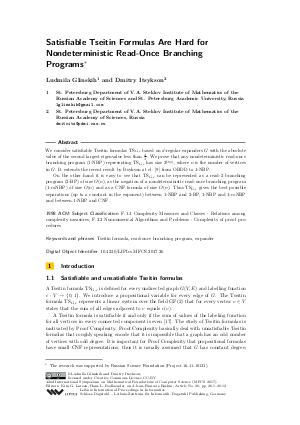Satisfiable Tseitin Formulas Are Hard for Nondeterministic Read-Once Branching Programs
Authors Ludmila Glinskih, Dmitry Itsykson
-
Part of:
Volume:
42nd International Symposium on Mathematical Foundations of Computer Science (MFCS 2017)
Part of: Series: Leibniz International Proceedings in Informatics (LIPIcs)
Part of: Conference: Mathematical Foundations of Computer Science (MFCS) - License:
 Creative Commons Attribution 3.0 Unported license
Creative Commons Attribution 3.0 Unported license
- Publication Date: 2017-12-01
File

PDF
LIPIcs.MFCS.2017.26.pdf
- Filesize: 464 kB
- 12 pages
Document Identifiers
Subject Classification
Keywords
- Tseitin formula
- read-once branching program
- expander
Metrics
- Access Statistics
-
Total Accesses (updated on a weekly basis)
0Document
0Metadata
Abstract
We consider satisfiable Tseitin formulas TS_{G,c} based on d-regular expanders G with the absolute value of the second largest eigenvalue less than d/3. We prove that any nondeterministic read-once branching program (1-NBP) representing TS_{G,c} has size 2^{\Omega(n)}, where n is the number of vertices in G. It extends the recent result by Itsykson at el. [STACS 2017] from OBDD to 1-NBP.
On the other hand it is easy to see that TS_{G,c} can be represented as a read-2 branching program (2-BP) of size O(n), as the negation of a nondeterministic read-once branching program (1-coNBP) of size O(n) and as a CNF formula of size O(n). Thus TS_{G,c} gives the best possible separations (up to a constant in the exponent) between
1-NBP and 2-BP, 1-NBP and 1-coNBP and between 1-NBP and CNF.
Cite As Get BibTex
Ludmila Glinskih and Dmitry Itsykson. Satisfiable Tseitin Formulas Are Hard for Nondeterministic Read-Once Branching Programs. In 42nd International Symposium on Mathematical Foundations of Computer Science (MFCS 2017). Leibniz International Proceedings in Informatics (LIPIcs), Volume 83, pp. 26:1-26:12, Schloss Dagstuhl – Leibniz-Zentrum für Informatik (2017)
https://doi.org/10.4230/LIPIcs.MFCS.2017.26
BibTex
@InProceedings{glinskih_et_al:LIPIcs.MFCS.2017.26,
author = {Glinskih, Ludmila and Itsykson, Dmitry},
title = {{Satisfiable Tseitin Formulas Are Hard for Nondeterministic Read-Once Branching Programs}},
booktitle = {42nd International Symposium on Mathematical Foundations of Computer Science (MFCS 2017)},
pages = {26:1--26:12},
series = {Leibniz International Proceedings in Informatics (LIPIcs)},
ISBN = {978-3-95977-046-0},
ISSN = {1868-8969},
year = {2017},
volume = {83},
editor = {Larsen, Kim G. and Bodlaender, Hans L. and Raskin, Jean-Francois},
publisher = {Schloss Dagstuhl -- Leibniz-Zentrum f{\"u}r Informatik},
address = {Dagstuhl, Germany},
URL = {https://drops.dagstuhl.de/entities/document/10.4230/LIPIcs.MFCS.2017.26},
URN = {urn:nbn:de:0030-drops-80767},
doi = {10.4230/LIPIcs.MFCS.2017.26},
annote = {Keywords: Tseitin formula, read-once branching program, expander}
}
Author Details
References
- Noga Alon and Fan R. K. Chung. Explicit construction of linear sized tolerant networks. Discrete Mathematics, 306(10-11):1068-1071, 2006. URL: http://dx.doi.org/10.1016/j.disc.2006.03.025.
-
L. Babai, P. Hajnal, E. Szemeredi, and G. Turan. A lower bound for read-once-only branching programs. Journal of Computer and System Sciences, 35:153-162, 1987.

- Eli Ben-Sasson. Hard examples for bounded depth Frege. In Proceedings on 34th Annual ACM Symposium on Theory of Computing, May 19-21, 2002, Montréal, Québec, Canada, pages 563-572, 2002. URL: http://dx.doi.org/10.1145/509907.509988.
- Allan Borodin, Alexander A. Razborov, and Roman Smolensky. On lower bounds for read-k-times branching programs. Computational Complexity, 3:1-18, 1993. URL: http://dx.doi.org/10.1007/BF01200404.
-
J Cheeger. A lower bound for the smallest eigenvalue of the laplacian. Problems Anal., page 195, 1970.

- Stephen A. Cook, Jeff Edmonds, Venkatesh Medabalimi, and Toniann Pitassi. Lower bounds for nondeterministic semantic read-once branching programs. In 43rd International Colloquium on Automata, Languages, and Programming, ICALP 2016, July 11-15, 2016, Rome, Italy, pages 36:1-36:13, 2016. URL: http://dx.doi.org/10.4230/LIPIcs.ICALP.2016.36.
- Pavol Duris, Juraj Hromkovic, Stasys Jukna, Martin Sauerhoff, and Georg Schnitger. On multi-partition communication complexity. Inf. Comput., 194(1):49-75, 2004. URL: http://dx.doi.org/10.1016/j.ic.2004.05.002.
-
D.M. Itsykson and A.A. Kojevnikov. Lower bounds of static Lovasz-Schrijver calculus proofs for Tseitin tautologies. Zapiski Nauchnykh Seminarov POMI, 340:10-32, 2006.

- Dmitry Itsykson, Alexander Knop, Andrei Romashchenko, and Dmitry Sokolov. On obdd-based algorithms and proof systems that dynamically change order of variables. In 34th Symposium on Theoretical Aspects of Computer Science, STACS 2017, March 8-11, 2017, Hannover, Germany, pages 43:1-43:14, 2017. URL: http://dx.doi.org/10.4230/LIPIcs.STACS.2017.43.
-
Stasys Jukna. A note on read-k times branching programs. ITA, 29(1):75-83, 1995.

- Stasys Jukna. A nondeterministic space-time tradeoff for linear codes. Inf. Process. Lett., 109(5):286-289, 2009. URL: http://dx.doi.org/10.1016/j.ipl.2008.11.001.
- László Lovász, Moni Naor, Ilan Newman, and Avi Wigderson. Search Problems in the Decision Tree Model. SIAM J. Discrete Math., 8(1):119-132, 1995. URL: http://dx.doi.org/10.1137/S0895480192233867.
-
A Lubotzky, R Phillips, and P Sarnak. Ramanujan graphs. Combinatorica, 8(3):261-277, 1988.

-
EA Okolnishnikova. On lower bounds for branching programs. Siberian Advances in Mathematics, 3(1):152-166, 1993.

- Toniann Pitassi, Benjamin Rossman, Rocco A. Servedio, and Li-Yang Tan. Poly-logarithmic Frege depth lower bounds via an expander switching lemma. In Proceedings of the 48th Annual ACM SIGACT Symposium on Theory of Computing, STOC 2016, Cambridge, MA, USA, June 18-21, 2016, pages 644-657, 2016. URL: http://dx.doi.org/10.1145/2897518.2897637.
- Jayram S. Thathachar. On separating the read-k-times branching program hierarchy. In Proceedings of the Thirtieth Annual ACM Symposium on the Theory of Computing, Dallas, Texas, USA, May 23-26, 1998, pages 653-662, 1998. URL: http://dx.doi.org/10.1145/276698.276881.
-
A. Urquhart. Hard examples for resolution. JACM, 34(1):209-219, 1987.

-
Ingo Wegener. Branching Programs and Binary Decision Diagrams. SIAM, 2000.

